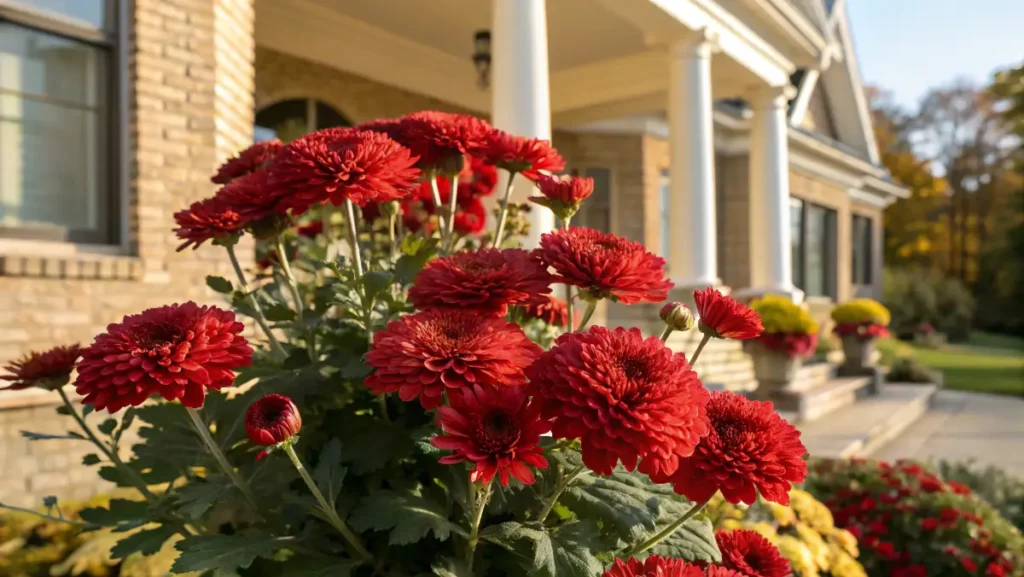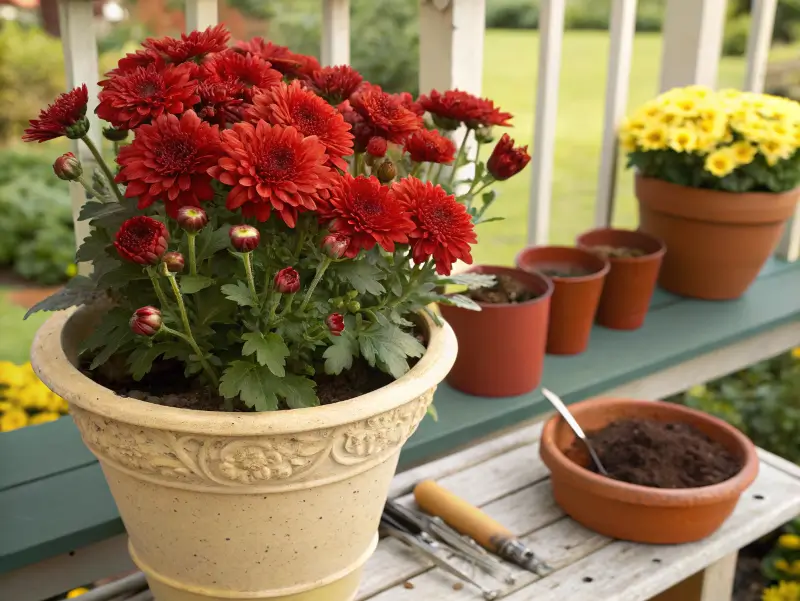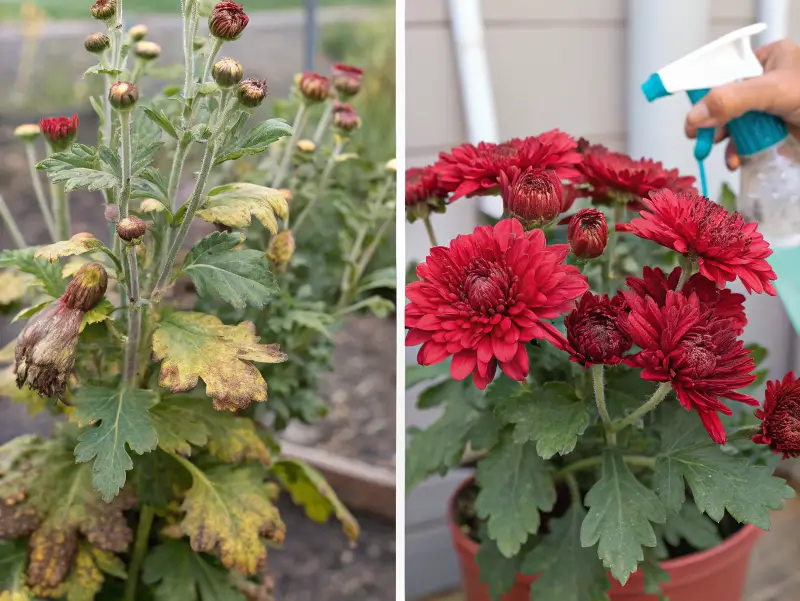
In This Article
Red chrysanthemum (Chrysanthemum morifolium) are stunning fall bloomers known for their vibrant, velvety petals in rich burgundy to bright scarlet shades. These moderately fast growers reach 1-3 feet tall and wide, creating gorgeous autumn displays. They love full sun and consistent moisture but hate soggy soil. Pretty easy to care for once established! While generally pet-safe, large amounts can cause mild stomach upset in curious cats and dogs.
Red Chrysanthemum Care and Growing Requirements
Let’s be real, chrysanthemums have a reputation for being finicky, but that’s honestly not fair! Once you know what they want, they’re pretty straightforward plants that’ll reward you big time.
Light Requirements
Your red chrysanthemum are basically sun worshippers. They need at least 6 hours of direct sunlight daily to produce those knockout blooms we all love. However, if you live somewhere with brutal afternoon sun, a little bit of afternoon shade actually helps protect those gorgeous red petals from fading.
Indoor mums are a different story though. Place them near your brightest window, but remember they’re temporary guests—they really want to be outside! During winter, if you’re trying to overwinter them indoors, supplemental grow lights can work wonders.
Watering Guidelines
Here’s where many folks mess up, red chrysanthemum like consistent moisture but absolutely hate soggy soil. Think of it like this: they want a nice drink, not a swimming pool!
Water when the top inch of soil feels dry. During hot summer months, this might mean daily watering. In cooler weather, every few days usually does the trick. Always water at the base of the plant to avoid getting the leaves wet, which can lead to disease issues.
Pro tip: Mulch around your red chrysanthemum plants to help retain moisture and keep those roots cool. Your mums will thank you for it!
Soil Preferences
Red chrysanthemum aren’t super picky about soil, but they do have preferences. They love well-draining, slightly acidic to neutral soil (pH 6.0-7.0). If your soil is heavy clay, work in some compost or perlite to improve drainage.
For container growing, use a good quality potting mix rather than garden soil. Garden soil gets too heavy in pots and doesn’t drain well enough.
Temperature and Humidity
Most red chrysanthemum are pretty hardy once established. They can handle temperatures down to about 20°F, but young plants need protection from harsh winds and extreme cold.
Humidity-wise, they’re not too fussy. Average household humidity works fine for indoor plants. Outside, good air circulation helps prevent fungal issues, especially in humid climates.
Fertilizer and Nutrition
Feed your red chrysanthemum regularly during the growing season, and they’ll put on quite the show! Use a balanced, water-soluble fertilizer every 2-3 weeks from spring through early fall.
Stop fertilizing about 6 weeks before your first expected frost. This helps the plants harden off for winter. Over-fertilizing can actually reduce bloom production, so don’t go overboard!
Popular Red Chrysanthemum Varieties and Types
The world of red chrysanthemum is incredibly diverse—honestly, it’s like a candy store for gardeners! Let me walk you through some favorites that never disappoint.
Decorative Red Varieties
‘Bolero’ is absolutely stunning with its deep red decorative blooms that look like they’re made of velvet. The flowers are huge—sometimes 4-5 inches across!
‘Matchstick’ is a real conversation starter with its red petals tipped in bright yellow. It looks like someone dipped each petal in sunshine.
‘Firecracker’ lives up to its name with bright red pompons that seem to explode with color. Perfect for that bold autumn statement.
Garden Mum Classifications
Mums come in several flower forms, and each has its own personality:
- Decorative types have flat, daisy-like flowers
- Pompon varieties are those perfect little round balls
- Anemone-flowered forms have a raised center surrounded by flat petals
- Spider and spoon-tip varieties have unique, twisted petals
Just like Yellow Chrysanthemum varieties, red chrysanthemum offer incredible diversity in form and size.
Seasonal Blooming Characteristics
Early red chrysanthemum varieties start showing color in late August, while late-season types keep going until hard frost. Mid-season bloomers are usually the most reliable for consistent fall color.
Flower size can vary dramatically too, from tiny button mums to dinner-plate sized blooms. The intensity of red chrysanthemum color often deepens as temperatures cool, giving you richer, more vibrant displays as fall progresses.
Pruning Your Red Chrysanthemum

Let’s face it, pruning red chrysanthemum isn’t anyone’s favorite job, but it’s absolutely worth the effort. Proper pruning makes the difference between scraggly plants and those gorgeous, bushy specimens you see at garden centers.
Timing and Techniques
Spring pruning of red chrysanthemum should happen when new growth starts appearing. Cut back any dead stems from winter, but leave the healthy growth alone.
The real magic happens with pinching. Starting in late spring, pinch back the growing tips every few weeks until mid-July. This creates bushier red chrysanthemum plants with way more flowers. Stop pinching by mid-July, or you’ll delay blooming.
Deadheading spent blooms keeps plants looking fresh and sometimes encourages a second flush of flowers. Don’t be shy about it, cut back to the next set of leaves.
Tools and Methods
Sharp, clean pruning shears are your best friend here. Wipe them down with rubbing alcohol between plants to prevent spreading diseases.
When pinching, you can literally use your fingers for soft new growth. For woody stems, use your pruning shears and make clean cuts just above a leaf node.
Encouraging Better Blooms
Regular pinching through summer results in plants with 3-4 times more flowers than unpinched plants. It’s honestly like magic! The trade-off is that blooms will be slightly smaller, but you’ll have so many more of them.
Propagating Red Chrysanthemums
Want more red chrysanthemum without buying new plants? Propagation is easier than you might think, and it’s incredibly satisfying too!
Division Method
Spring division is the easiest way to multiply your red chrysanthemum. Dig up established clumps just as new growth starts appearing. Use a sharp spade to cut the clump into sections, making sure each piece has roots and shoots.
Replant red chrysanthemum divisions immediately and water well. They might look a bit sad at first, but they’ll bounce back quickly. This also rejuvenates older plants that have gotten woody in the center.
Cutting Propagation
Take 4-6 inch cuttings from healthy, non-flowering shoots in late spring or early summer. Remove the lower leaves and dip in rooting hormone if you have it.
Stick cuttings in a mix of perlite and peat moss, keeping them consistently moist. Most cuttings root within 2-3 weeks. It’s honestly pretty exciting to see those little white roots developing!
Growing from Seed
Growing mums from seed is possible but honestly not recommended for specific varieties. The results are unpredictable, and it takes much longer than other methods.
If you want to try it, start seeds indoors in late winter. They need light to germinate, so just press them onto the soil surface rather than covering them.
Potting and Repotting Guidelines

Container growing is perfect for red chrysanthemum, especially if you want to move them around for seasonal displays. Plus, it makes overwintering much easier in colder climates!
Container Selection
Choose pots that are at least 12 inches wide for single plants. Drainage holes are absolutely non-negotiable, seriously, mums will rot in waterlogged soil faster than you can say “oops.”
Terra cotta pots are great because they breathe, but plastic works fine too. Just make sure whatever you choose is big enough for the plant to grow.
Potting Mix Requirements
Use a high-quality potting mix, never garden soil. I like mixes that contain perlite for drainage and some organic matter for nutrition.
The pH should be slightly acidic to neutral. Most commercial potting mixes are already balanced, so you probably don’t need to worry about adjusting it.
Repotting Schedule
Red chrysanthemum are fast growers, so they often need repotting every year or two. Signs it’s time include roots growing out of drainage holes or water running straight through without being absorbed.
Spring is the best time for repotting, just as new growth begins. Go up one pot size, jumping to a much larger pot can actually cause problems.
Common Pests and Diseases
Even the healthiest red chrysanthemums can run into pest and disease issues. The good news? Most problems are totally manageable if you catch them early.
Frequent Pest Issues
Aphids love tender new growth and can multiply incredibly fast. Look for clusters of tiny green or black insects on stems and leaves. A strong spray of water often knocks them off, or you can use insecticidal soap.
Spider mites show up as tiny webs and stippled leaves. They love hot, dry conditions. Increase humidity around plants and use predatory mites or miticide if needed.
Thrips cause silvery streaks on leaves and can spread viruses. Blue sticky traps help monitor and catch adult thrips.
Disease Prevention
Powdery mildew looks like someone dusted your plants with flour. It’s usually caused by poor air circulation and high humidity. Space plants properly and avoid overhead watering.
Root rot happens when soil stays too wet. Prevention is key, make sure drainage is good and don’t overwater.
According to the USDA National Institute of Food and Agriculture, proper plant spacing and air circulation are crucial for preventing many common chrysanthemum diseases.
Integrated Pest Management
Encourage beneficial insects like ladybugs and lacewings that eat aphids. Plant diverse flowers nearby to provide habitat for these helpful predators.
Sometimes chemical controls are necessary, but always start with the gentlest options first. Neem oil works well for many pest issues and is relatively safe for beneficial insects.
Troubleshooting Common Red Chrysanthemum Problems

Every gardener runs into issues eventually, don’t worry, it’s all part of the learning process! Here are the most common problems and how to fix them.
Foliage Issues
Yellowing leaves usually means watering issues. Too much water causes yellowing from the bottom up, while too little water causes yellowing and wilting all over.
Brown leaf tips often indicate low humidity or fertilizer burn. Check your feeding schedule and consider misting around (not on) the plants.
Wilting despite adequate water might mean root rot or pest damage. Check the roots—healthy ones should be white or cream-colored, not brown and mushy.
Flowering Problems
Failure to bloom is often caused by too much nitrogen fertilizer or not enough sunlight. Reduce feeding and make sure plants get adequate light.
Poor flower color can happen when plants don’t get enough sunlight or when temperatures are too warm. Red colors develop best in cool fall weather.
Sometimes plants that look just like Red Geraniums in their vibrant color intensity need that cool weather trigger to really show their true potential.
Environmental Stress
Heat stress shows up as wilting during the hottest part of the day, even with adequate water. Provide afternoon shade or move containers to cooler spots.
Cold damage appears as blackened, mushy growth after frost. Cut back damaged parts and protect plants from future cold snaps.
Transplant shock is normal for newly planted mums. Keep them well-watered but not soggy, and they’ll usually recover within a week or two.
Frequently Asked Questions
What do red chrysanthemum symbolize? Red chrysanthemum symbolize love, passion, and deep romantic feelings. In many cultures, they represent devotion, honor, and respect, making them popular choices for expressing strong emotions and commemoration. Pretty romantic for a fall flower, right?
What does the red chrysanthemum mean in Japan? In Japanese culture, red chrysanthemum represent the sun and are associated with longevity, rejuvenation, and nobility. They’re particularly significant since the chrysanthemum is Japan’s imperial flower. The Japanese really know their flower meanings!
Are there red chrysanthemum? Absolutely! Red chrysanthemum come in numerous varieties, ranging from deep burgundy to bright scarlet shades. They’re among the most popular colors for both garden displays and cut flower arrangements.
What is the negative meaning of chrysanthemums? In some European cultures, chrysanthemums are associated with death and mourning, traditionally used for funeral arrangements. However, this varies significantly by culture and region. In most of North America, they’re simply beautiful fall flowers without negative connotations.
Red chrysanthemum really are the stars of the autumn garden. With their incredible range of colors, forms, and sizes, there’s honestly a perfect variety for every gardener. Whether you’re growing them in containers for seasonal displays or planting them as permanent perennials, these gorgeous flowers will reward your care with months of spectacular blooms.
Remember, gardening is supposed to be fun! Don’t stress too much about perfect care, mums are more forgiving than their reputation suggests. Start with a few plants, learn what works in your specific conditions, and before you know it, you’ll be the neighborhood’s go-to person for chrysanthemum advice. Happy gardening!

4 thoughts on “Red Chrysanthemum: Ultimate Care & Growing Guide”
Comments are closed.